The Ultimate Guide to Vanda Orchid Care: A Comprehensive Blog for Thriving Blooms
Welcome, fellow orchid enthusiasts! Today, we delve into the captivating world of Vanda orchids, renowned for their vibrant, often large, and uniquely patterned flowers. Native to the tropical regions of Asia, these epiphytic beauties possess an allure that has captivated plant lovers for centuries. Whether you are a seasoned orchid grower or a curious beginner, this comprehensive guide will equip you with the knowledge and techniques to cultivate healthy and floriferous Vanda orchids, specifically tailored for the climate of Bengaluru, Karnataka, India.
Understanding Vanda Orchids: Epiphytes of the Tropics
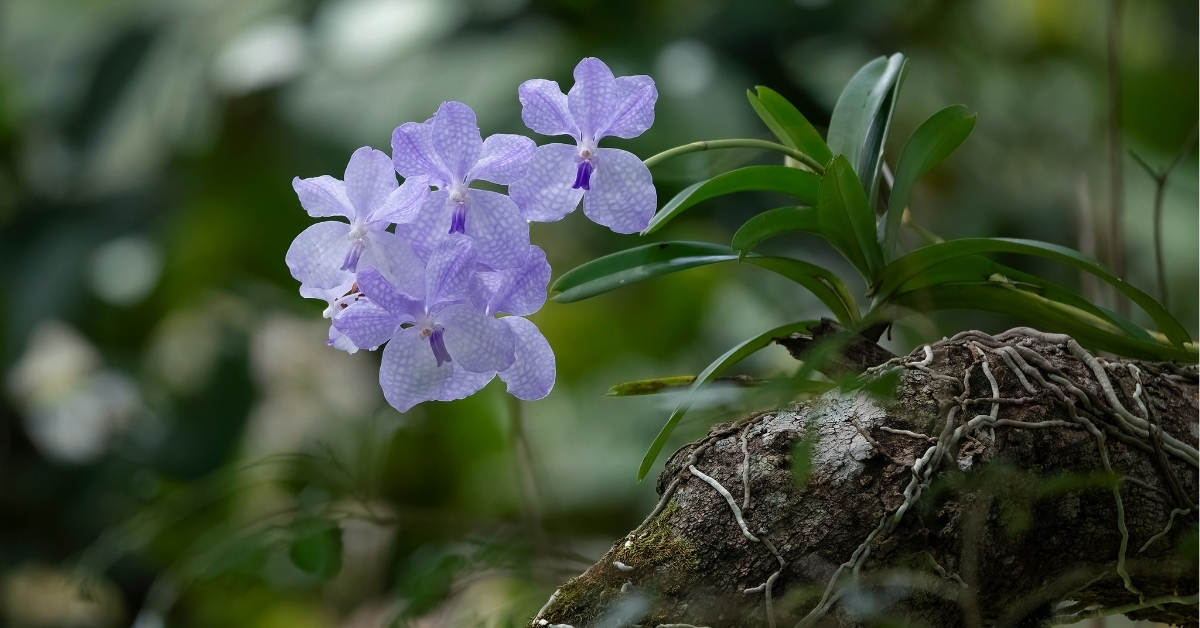
Vanda orchids are epiphytes, meaning they naturally grow on other plants, typically trees, using their roots to anchor themselves and absorb moisture and nutrients from the air, rain, and decaying organic matter. This unique characteristic dictates their care requirements, setting them apart from terrestrial plants that grow in soil. In Bengaluru's warm and humid climate, with distinct wet and dry seasons, understanding these natural adaptations is crucial for successful Vanda cultivation.
Essential Care Requirements for Your Vanda Orchid:
Let's break down the essential aspects of Vanda orchid care, drawing inspiration from the information provided and expanding with detailed insights relevant to the Bengaluru environment.
1. Potting and Mounting: Providing the Right Support
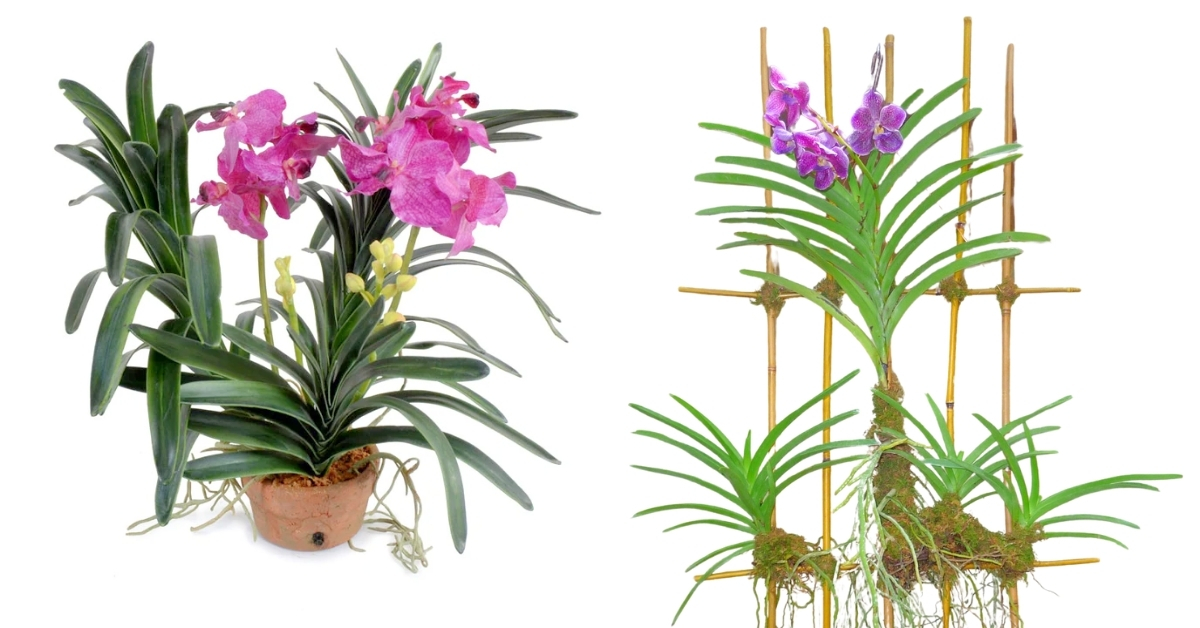
- The Epiphytic Nature: As epiphytes, Vanda orchids thrive with ample air circulation around their roots. Traditional potting mixes used for terrestrial plants will retain too much moisture, leading to root rot – a common demise for Vandas.
- Ideal Containers: The image suggests using slotted pots, wood baskets, or wood mounts. These options allow the roots to breathe and dry out quickly after watering, mimicking their natural environment.
- Slotted Pots: These plastic pots have numerous openings on the sides, promoting airflow. They can be used with a very coarse media or even without any media at all for mature plants in humid environments.
- Wood Baskets: Teakwood baskets are particularly popular as they are durable and provide excellent drainage and aeration. The roots can grow out through the slats, creating a natural and visually appealing display.
- Wood Mounts: Attaching Vandas to pieces of driftwood or cork bark allows the roots to cling naturally. This method requires more frequent watering and high humidity, making it suitable for experienced growers or those with controlled environments.
- Growing Without Media: In highly humid environments like Bengaluru during the monsoon, mature Vanda orchids can be grown successfully without any potting media in baskets or on mounts. Their roots will absorb moisture directly from the air. However, younger plants or those in drier conditions might benefit from a very coarse media to retain some moisture.
- Coarse Media Options: If using media, opt for materials that provide excellent drainage and aeration, such as:
- Charcoal: Horticultural charcoal helps with drainage, aeration, and can absorb some impurities.
- Treated Coco Chips: Large-grade coco chips that have been properly treated to remove excess salts are another good option. They retain some moisture while still allowing for airflow. Ensure the chips are not too fine.
2. Watering: Mimicking Tropical Rains
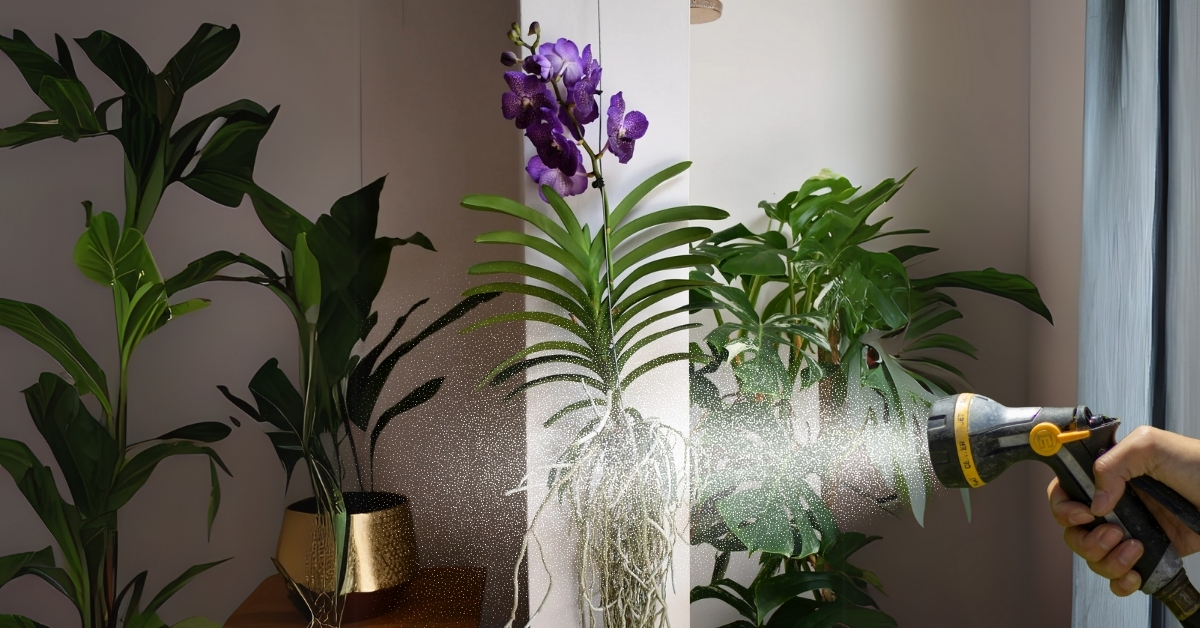
- Thorough Drenching: The image correctly advises watering thoroughly by drenching the roots in water for 10 to 15 minutes on alternative days. This allows the aerial roots to fully absorb the moisture they need.
- Water Quality: In Bengaluru, tap water can sometimes be hard or contain chlorine. Ideally, use rainwater, distilled water, or reverse osmosis water if possible. If using tap water, let it sit for 24 hours to allow chlorine to dissipate.
- Frequency Adjustment: The watering frequency may need adjustment based on the season and humidity levels in Bengaluru. During the drier months (winter and pre-monsoon), you might need to water more frequently, perhaps daily, especially for plants grown without media or on mounts. During the monsoon, when humidity is high, you might be able to extend the watering intervals slightly.
- Observing the Roots: A key indicator of proper watering is the color of the roots. Healthy, well-hydrated Vanda roots will turn green when wet and silvery-white when dry. Water when the roots are silvery-white.
- Time of Day: Water your Vanda orchids in the morning. This allows the foliage and roots to dry out during the day, reducing the risk of fungal diseases, which can thrive in warm, moist conditions.
3. Fertilizers: Nourishing for Vibrant Blooms
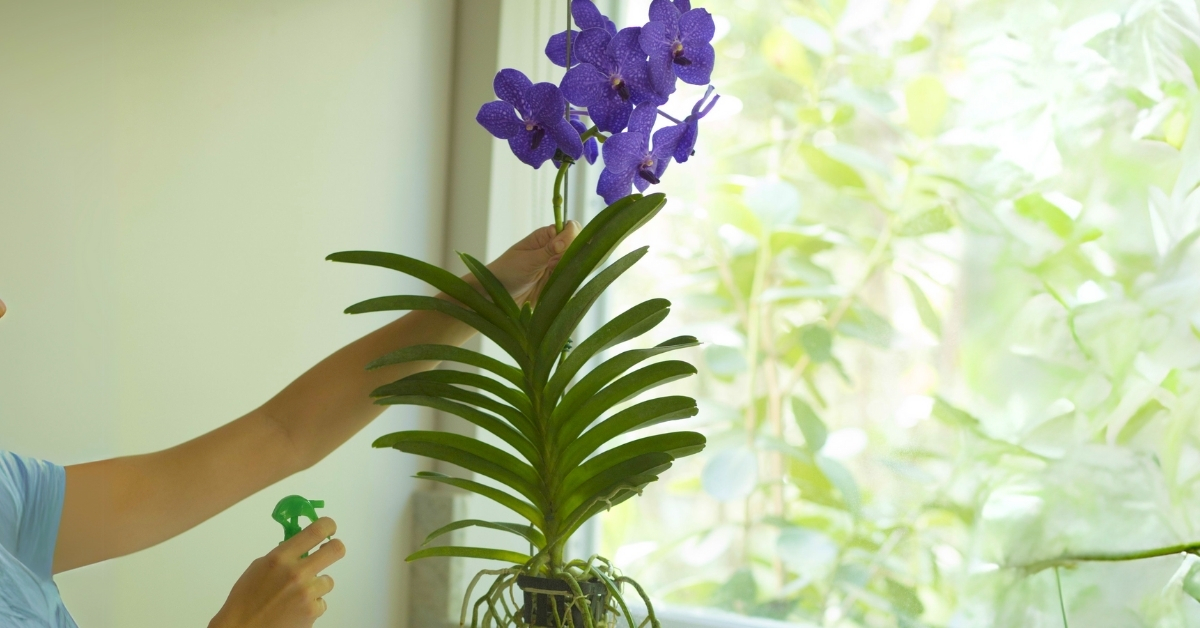
- Balanced Nutrition: The image recommends using a water-soluble NPK 19-19-19 fertilizer. This balanced formula provides the essential macronutrients (Nitrogen, Phosphorus, Potassium) in equal proportions, supporting overall healthy growth.
- Dilution is Key: Always use the fertilizer at half the recommended strength (half a teaspoon in one liter of water) to avoid burning the sensitive roots. Vanda orchids are heavy feeders but are also sensitive to high concentrations of salts.
- Weekly Application: Fertilize your Vanda orchids weekly during their active growing season (typically spring and summer in Bengaluru). You can incorporate this into your watering routine.
- Drenching and Spraying: The image suggests thoroughly drenching the media (if used) and spraying the plant as well. Foliar feeding allows the plant to absorb nutrients through its leaves, but root feeding is equally important. Ensure the fertilizer solution reaches all parts of the root system.
- Flushing: Once a month, water your Vanda orchid thoroughly with plain water to flush out any accumulated salts from the fertilizer. This prevents salt buildup that can damage the roots over time.
- Seasonal Adjustments: During the cooler and less actively growing months (winter in Bengaluru), you can reduce the frequency of fertilization to once every two to four weeks. You can also consider using a bloom-boosting fertilizer (higher in phosphorus) a few times a year to encourage flowering.
4. Light: The Energy Source for Growth and Blooming
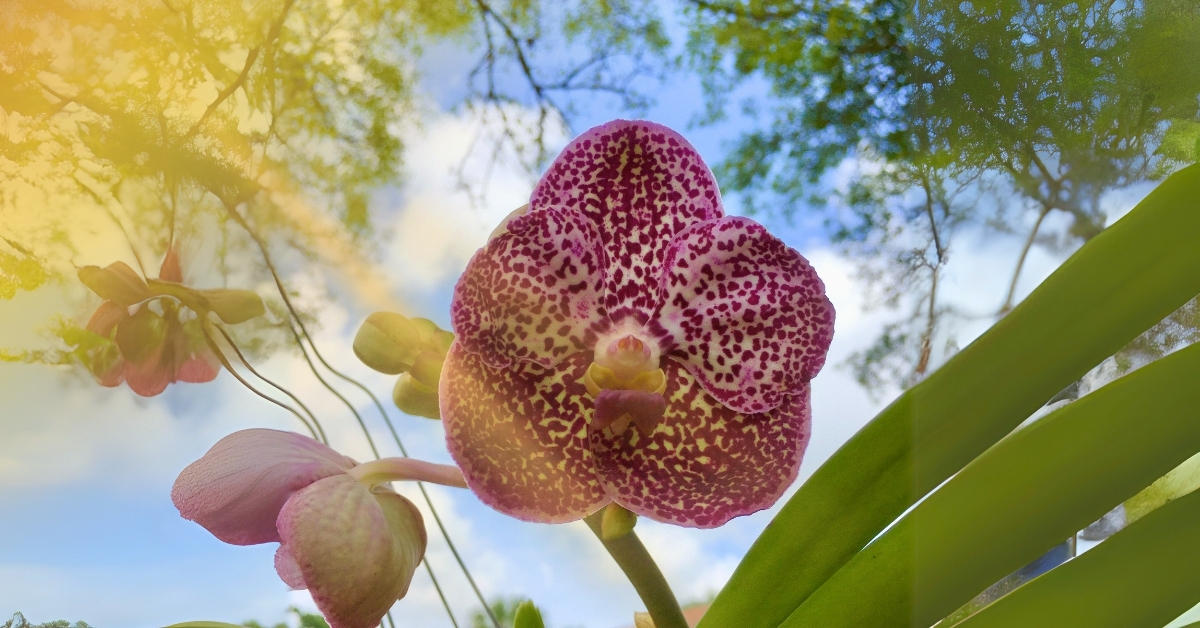
- Bright, Indirect Sunlight: Vanda orchids require bright light to thrive and bloom profusely. Aim for 3 to 5 hours of direct sunlight per day, as suggested in the image. However, the intensity of direct sunlight in Bengaluru can be quite high, especially during the summer months.
- Protection from Scorching: During the hottest part of the day (midday), especially from March to May in Bengaluru, provide some form of shading to protect the leaves from sunburn. A shade cloth or placing the orchid under the filtered light of a tree can be beneficial.
- Ideal Location: An east or west-facing location that receives bright morning or afternoon sun is ideal. A south-facing location can also work if you provide adequate shading during the peak hours.
- Leaf Color as an Indicator: The color of the leaves can indicate if your Vanda is receiving the right amount of light. Healthy leaves should be a medium green. Dark green leaves often indicate insufficient light, while reddish or yellowing leaves can be a sign of too much direct sun.
- Artificial Light: If natural light is insufficient, especially indoors, you can supplement with artificial grow lights. LED grow lights are an energy-efficient option.
5. Humidity: Creating a Tropical Ambiance
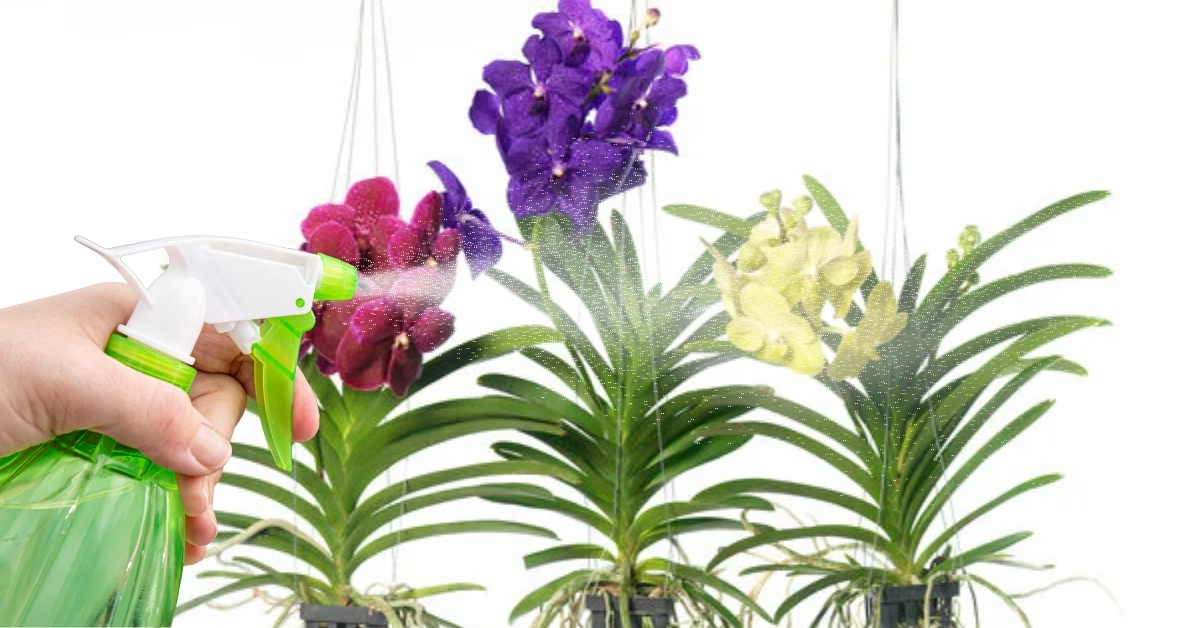
- High Humidity Preference: Vanda orchids thrive in high humidity levels, ideally between 60% and 80%. Bengaluru's climate generally offers good humidity, especially during the monsoon season. However, during the drier months, you might need to take steps to increase humidity.
- Misting: The image recommends daily misting of the plant with water one to two times. This helps to increase the humidity around the orchid, especially for the aerial roots. Use room temperature water for misting.
- Humidity Trays: Placing your Vanda orchid above a tray filled with pebbles and water (ensuring the bottom of the pot or mount is not in direct contact with the water) can increase local humidity through evaporation.
- Grouping Plants: Grouping several humidity-loving plants together can create a more humid microclimate.
- Humidifiers: In particularly dry conditions, a humidifier can be used to maintain optimal humidity levels.
- Air Circulation: While high humidity is beneficial, good air circulation is equally important to prevent fungal diseases. Ensure your Vanda orchid is placed in a location with gentle airflow.
Thriving in Bengaluru's Climate: Specific Considerations
- Monsoon Season (June to October): Bengaluru experiences significant rainfall and high humidity during the monsoon. Adjust your watering schedule accordingly, as the orchid will receive moisture from the rain. Ensure good drainage to prevent waterlogging. Increased humidity can also increase the risk of fungal diseases, so maintain good air circulation.
- Winter Season (November to February): Winters in Bengaluru are relatively mild and dry. You might need to increase watering frequency and take measures to maintain humidity levels, such as misting more often or using humidity trays.
- Summer Season (March to May): Summers can be hot and dry. Provide adequate shade during the hottest part of the day and water more frequently to prevent dehydration. Misting can be especially beneficial during this time.
Common Problems and Solutions:
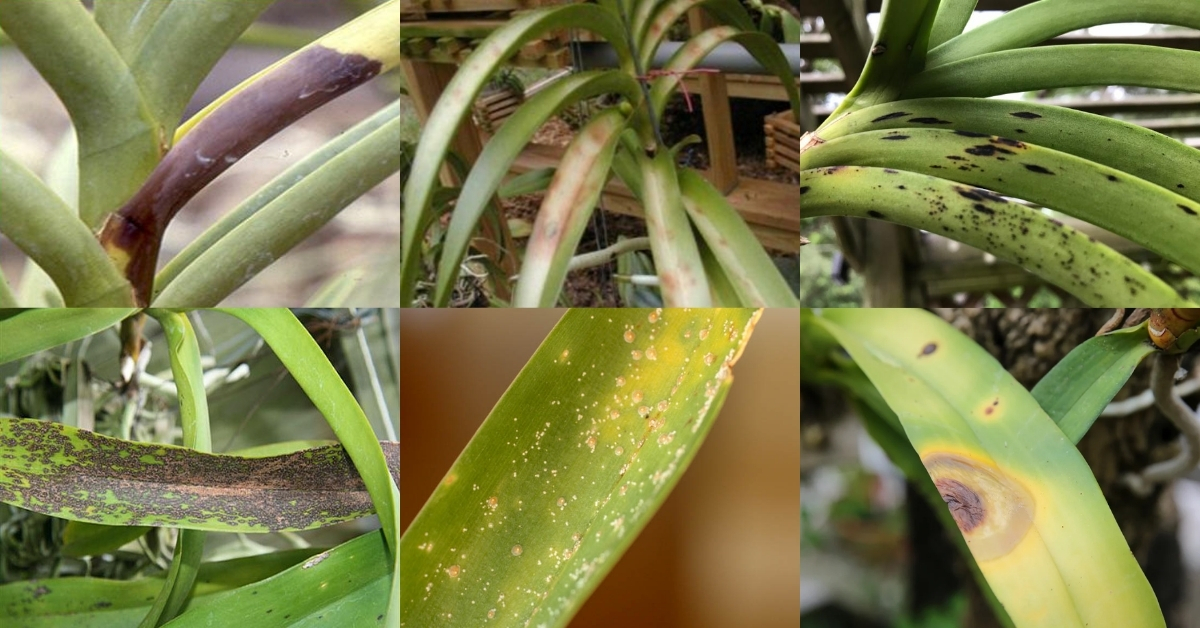
- Root Rot: Caused by overwatering and poor drainage. Solution: Use appropriate potting methods (baskets, mounts, slotted pots), ensure good drainage, and allow roots to dry out between waterings. Remove any rotted roots with sterilized tools.
- Leaf Burn: Caused by excessive direct sunlight. Solution: Provide shade during the hottest part of the day. Acclimate the plant gradually if moving it to a brighter location.
- Fungal Diseases: Thrive in warm, humid conditions with poor air circulation. Solution: Ensure good air circulation, avoid wetting the leaves when watering, and treat with a suitable fungicide if necessary.
- Pests: Common orchid pests like mealybugs and spider mites can sometimes affect Vandas. Solution: Regularly inspect your plant for pests and treat infestations with insecticidal soap or neem oil.
Encouraging Blooming: The Reward of Proper Care
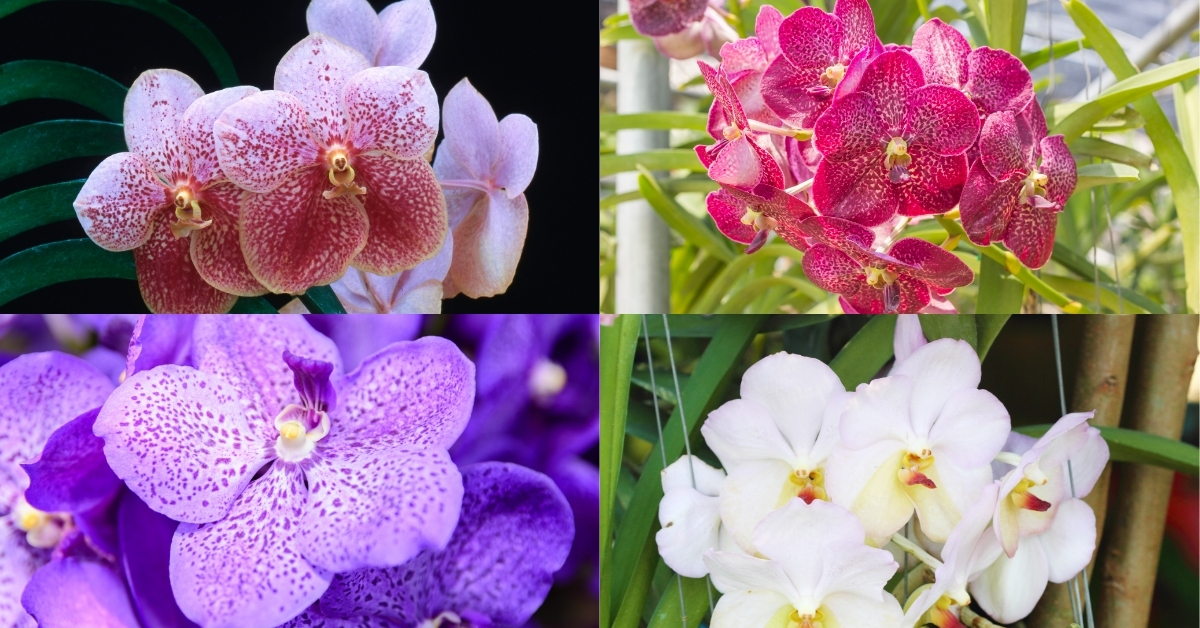
Consistent adherence to the care guidelines mentioned above is crucial for encouraging your Vanda orchid to bloom. Mature and healthy Vanda orchids can bloom multiple times a year, producing stunning displays of colorful flowers. Ensure the plant receives adequate light, proper watering and fertilization, and experiences a slight temperature difference between day and night, which can help initiate flowering.


